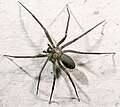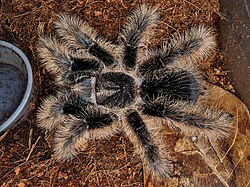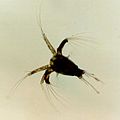Arthropod
Arthropods (Greek language for "joint-legged") are a large group of invertebrate animals. Insects, spiders, crabs, shrimp, millipedes, and centipedes are all arthropods. In the scientific classification, all arthropods are members of the phylum Arthropoda. Arthropods have segmented body, an exoskeleton and legs with joints. Most arthropods live on land, but some live in water. Arthropods have by far the greatest number of species of any animal group. Arthropods are a source of food for many animals, including humans.
| Arthropoda | |
|---|---|

| |
| Centipede | |
| Scientific classification | |
| Kingdom: | |
| (unranked): | |
| Phylum: | Arthropoda
|
| Classes | |
| |
Diversity
Scientists know of more than 1 million species of arthropods. 80% of all known animal species are arthropods. Many more species have not yet been described.
Most arthropod species are insects. "Insects are the most diverse organisms in the history of life".[1]
Most arthropods live on land. The phylum Arthropoda is the only phylum of invertebrates that mostly live on land. But crustaceans (crabs, shrimp and their relatives) mostly live in water.
Arthropods are also the first phylum to develop genuine flight.
Description
Arthropods have a hard exoskeleton. The exoskeleton reduces the loss of water (desiccation). This helps them to live on land without drying out.
Classification
Arthropods are made up of four groups of living animals and one group of extinct animals:
- Chelicerates include mites, horseshoe crabs, scorpions and spiders.
- Myriapods include millipedes and centipedes.
- Crustaceans include barnacles, crabs, shrimp, crayfish, and lobsters. Most crustaceans live in water, with the most notable exception of woodlice.
- Hexapods include insects and a few other organisms. Hexapods have six legs.
- Trilobites are a group of extinct arthropods. Trilobites all lived in oceans. They disappeared in the Permian–Triassic extinction event, about 252 million years ago. The trilobites are the second most famous type of fossils, after the dinosaurs.
Images
Arthropod Media
Protaetia cuprea (copper chafer). Beetles are the most diverse order of arthropods.
Respiration and circulation in a myodocopid ostracod. Simplified transverse section through anterior body and carapace, showing gaseous diffusion through the inner lamella of the carapace (yellow arrows)
Central nervous system of a nectiopod remipede, showing the presence of both deutocerebrum (dc) and ventral nerve cord (vnc) organized by segmented ganglia.
Long bristles (setae) of a Tliltocatl albopilosus tarantula
The nauplius larva of a penaeid shrimp
References
| Wikimedia Commons has media related to Lua error in Module:Commons_link at line 62: attempt to index field 'wikibase' (a nil value).. |
| Wikispecies has information on: Arthropoda. |
- ↑ Grimaldi D. and Engel M.S. 2005. Evolution of the insects. Cambridge University Press, p1. ISBN 0-521-82149-5










